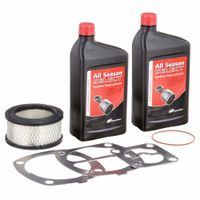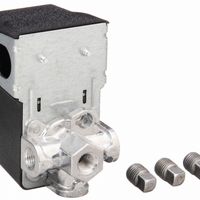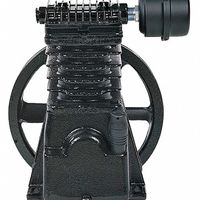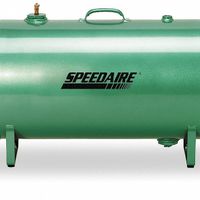Call +(254) 703 030 000 / 751 483 999 / 721 704 777
- Home
- Pneumatics
- Air Compressors Vacuum Pumps Blowers
- Air Compressors
.....Read More
Frequently Asked Questions
What size air compressor do I need for my tools?
To determine the appropriate size air compressor for your tools, consider the following factors:
1. **Tool Requirements**: Check the air consumption (CFM - Cubic Feet per Minute) and pressure (PSI - Pounds per Square Inch) requirements for each tool. This information is usually found in the tool's manual or on the manufacturer's website.
2. **CFM Rating**: Add up the CFM requirements of all tools you plan to use simultaneously. For intermittent use, consider the tool with the highest CFM and add a 30-50% buffer to ensure efficiency.
3. **PSI Rating**: Ensure the compressor can deliver the maximum PSI required by your tools. Most tools operate between 90-100 PSI, but some may require more.
4. **Tank Size**: Larger tanks (measured in gallons) allow for longer tool operation without the compressor needing to cycle on. For continuous use tools, a larger tank is beneficial.
5. **Duty Cycle**: This indicates how long the compressor can run before needing a rest. A higher duty cycle (e.g., 75%) is better for frequent use.
6. **Portability**: Consider whether you need a stationary or portable compressor. Portable models are smaller and easier to move but may have lower capacity.
7. **Power Source**: Decide between electric or gas-powered compressors based on your work environment. Electric is suitable for indoor use, while gas is better for outdoor or remote locations.
8. **Future Needs**: Consider potential future tool acquisitions that may require more power.
In summary, match the compressor's CFM and PSI to your tools' needs, choose an appropriate tank size, and consider duty cycle and portability for optimal performance.
How do I maintain an air compressor?
To maintain an air compressor, follow these steps:
1. **Read the Manual**: Always start by reading the manufacturer's manual for specific maintenance guidelines.
2. **Check Oil Levels**: For oil-lubricated compressors, regularly check and change the oil. Use the recommended oil type and change it after the first 20 hours of use, then every 200 hours or as specified.
3. **Inspect Air Filters**: Clean or replace air filters regularly to ensure efficient operation. Dirty filters can reduce performance and increase wear.
4. **Drain Moisture**: Daily, drain the moisture from the tank using the drain valve to prevent rust and corrosion.
5. **Inspect Hoses**: Regularly check hoses for cracks or leaks and replace them if necessary to prevent air loss and inefficiency.
6. **Check Safety Valve**: Test the safety valve by pulling it to ensure it releases air pressure properly.
7. **Tighten Fasteners**: Periodically check and tighten all bolts and nuts to prevent parts from loosening due to vibration.
8. **Clean Intake Vents**: Keep the intake vents clean and free from obstructions to ensure proper airflow.
9. **Inspect Belts**: For belt-driven models, check the condition and tension of the belts. Replace if worn or frayed.
10. **Monitor Temperature**: Ensure the compressor is operating within the recommended temperature range to prevent overheating.
11. **Check Electrical Components**: Inspect wiring and connections for signs of wear or damage.
12. **Store Properly**: When not in use, store the compressor in a clean, dry place to prevent damage.
13. **Schedule Professional Maintenance**: Periodically have a professional service the compressor to ensure all components are in good working order.
Regular maintenance ensures longevity, efficiency, and safety of your air compressor.
What is the difference between single-stage and two-stage air compressors?
Single-stage air compressors compress air in one stroke. Air is drawn into a cylinder, compressed to its final pressure in a single piston stroke, and then delivered to a storage tank. This type is typically used for lower pressure applications, usually up to 125 psi, and is suitable for tasks like inflating tires, powering small tools, and other light-duty applications.
Two-stage air compressors, on the other hand, compress air in two stages. Initially, air is drawn into a cylinder and compressed to an intermediate pressure. It is then cooled, often by an intercooler, before entering a second cylinder where it is compressed to a higher final pressure. This process allows two-stage compressors to achieve higher pressures, typically up to 175 psi or more, making them suitable for heavy-duty applications such as powering industrial machinery, large-scale manufacturing, and continuous operation tasks.
The key differences lie in their efficiency, pressure capacity, and application suitability. Two-stage compressors are generally more efficient for high-pressure applications due to the cooling process between stages, which reduces the work needed for the second compression. They are also more durable and have a longer lifespan under continuous use. Single-stage compressors are simpler, less expensive, and easier to maintain, making them ideal for home or small workshop use where high pressure is not required.
How do I calculate the CFM requirements for my air tools?
To calculate the CFM (Cubic Feet per Minute) requirements for your air tools, follow these steps:
1. **Identify Tool Requirements**: Check the manufacturer's specifications for each air tool to find the required CFM at a specific PSI (Pounds per Square Inch). This information is usually found in the tool's manual or on the manufacturer's website.
2. **List All Tools**: Make a list of all the air tools you plan to use simultaneously. Note their individual CFM requirements.
3. **Calculate Total CFM**: Add the CFM requirements of all the tools you plan to use at the same time. This gives you the total CFM needed.
4. **Consider Duty Cycle**: If tools are not used continuously, adjust for the duty cycle. For example, if a tool is used 50% of the time, multiply its CFM by 0.5.
5. **Add a Safety Margin**: Add a 25-30% safety margin to the total CFM to account for inefficiencies and future needs. Multiply the total CFM by 1.25 or 1.3.
6. **Check Compressor Specifications**: Ensure your air compressor can deliver the total CFM at the required PSI. The compressor's CFM rating should meet or exceed your calculated requirement.
7. **Consider PSI Requirements**: Ensure the compressor can also meet the PSI requirements of the tools. Some tools may require higher PSI, which can affect the CFM output of the compressor.
8. **Account for Losses**: Consider potential air losses due to hose length, fittings, and other factors. Longer hoses and more connections can reduce effective CFM.
By following these steps, you can accurately determine the CFM requirements for your air tools and ensure your air compressor is adequately sized.
Can I use an air compressor for painting?
Yes, you can use an air compressor for painting. An air compressor can be paired with a paint sprayer to apply paint evenly and efficiently over surfaces. This method is commonly used for automotive painting, home interiors, furniture, and other projects requiring a smooth finish.
To use an air compressor for painting, ensure the compressor has the appropriate specifications for your paint sprayer. The compressor should provide sufficient air pressure (measured in PSI) and air volume (measured in CFM) to match the requirements of the spray gun. Typically, a compressor with at least 2-3 horsepower and a tank capacity of 20 gallons or more is recommended for continuous painting tasks.
Choose the right type of spray gun: HVLP (High Volume Low Pressure) guns are popular for their efficiency and reduced overspray, making them suitable for detailed work. LVLP (Low Volume Low Pressure) guns are also an option for smaller compressors.
Prepare the surface by cleaning and sanding it to ensure the paint adheres properly. Mix the paint according to the manufacturer's instructions, and strain it to remove any impurities that could clog the spray gun.
Adjust the air pressure and fluid flow on the spray gun to achieve the desired spray pattern. Test the setup on a scrap surface to ensure even coverage and make necessary adjustments.
Wear appropriate safety gear, including a mask, goggles, and gloves, to protect against paint fumes and overspray. Work in a well-ventilated area to ensure safety and optimal drying conditions.
Regularly maintain the equipment by cleaning the spray gun and compressor after use to prevent clogs and ensure longevity.
How do I troubleshoot common air compressor problems?
To troubleshoot common air compressor problems, follow these steps:
1. **Check Power Supply**: Ensure the compressor is plugged in and the circuit breaker is not tripped. Verify the power switch is on.
2. **Inspect Air Leaks**: Listen for hissing sounds indicating leaks. Use soapy water to detect leaks around fittings and hoses. Tighten or replace faulty components.
3. **Examine Pressure Settings**: Ensure the pressure switch is set correctly. Adjust the cut-in and cut-out pressures if necessary.
4. **Review Air Filter**: A clogged air filter can reduce efficiency. Clean or replace the filter regularly to maintain airflow.
5. **Assess Oil Levels**: For oil-lubricated compressors, check the oil level and quality. Refill or change the oil if it appears dirty or low.
6. **Evaluate Safety Valve**: Test the safety valve to ensure it releases pressure at the correct level. Replace if it fails to function properly.
7. **Inspect Belts and Pulleys**: Check for wear and tension in belts and pulleys. Adjust or replace as needed to prevent slippage.
8. **Monitor Temperature**: Overheating can cause shutdowns. Ensure proper ventilation and clean cooling fins to prevent overheating.
9. **Check for Blockages**: Inspect the intake and exhaust for obstructions. Clear any debris to ensure proper airflow.
10. **Test Pressure Relief Valve**: Ensure the pressure relief valve is operational to prevent over-pressurization.
11. **Examine Electrical Components**: Inspect wiring and connections for damage. Replace any frayed wires or faulty components.
12. **Listen for Unusual Noises**: Unusual sounds may indicate mechanical issues. Investigate and address any abnormal noises promptly.
13. **Consult Manual**: Refer to the user manual for specific troubleshooting tips and maintenance schedules.
If problems persist, consider consulting a professional technician for further diagnosis and repair.
What is the lifespan of an air compressor?
The lifespan of an air compressor can vary significantly based on several factors, including the type of compressor, its usage, maintenance, and operating conditions. Generally, a well-maintained air compressor can last anywhere from 10 to 15 years, but this can extend to 20 years or more with optimal care.
1. **Type of Compressor**:
- **Reciprocating Compressors**: Typically have a lifespan of 10 to 15 years. They are often used in smaller applications and require regular maintenance.
- **Rotary Screw Compressors**: Known for their durability, these can last 15 to 20 years. They are commonly used in industrial settings and are designed for continuous operation.
- **Centrifugal Compressors**: These are used in large-scale industrial applications and can last 20 years or more with proper maintenance.
2. **Usage**:
- Compressors used in heavy-duty applications or continuously operated will generally have a shorter lifespan compared to those used intermittently or for lighter tasks.
3. **Maintenance**:
- Regular maintenance, including oil changes, filter replacements, and inspections, is crucial for extending the lifespan. Neglecting maintenance can lead to premature wear and failure.
4. **Operating Conditions**:
- Environmental factors such as temperature, humidity, and dust can impact the lifespan. Operating in harsh conditions without adequate protection or cooling can reduce longevity.
5. **Quality and Brand**:
- Higher-quality compressors from reputable brands often have longer lifespans due to better materials and engineering.
In summary, while the average lifespan of an air compressor is around 10 to 15 years, diligent maintenance and favorable operating conditions can significantly extend its service life.





